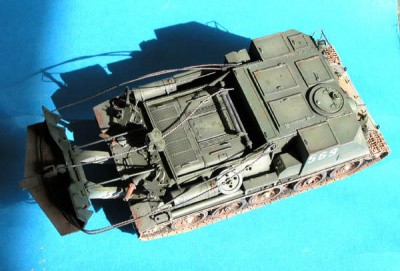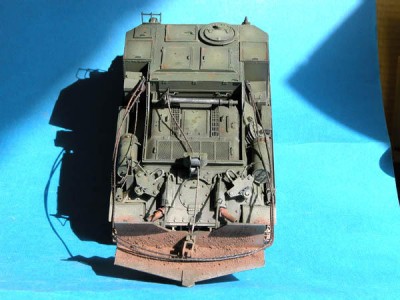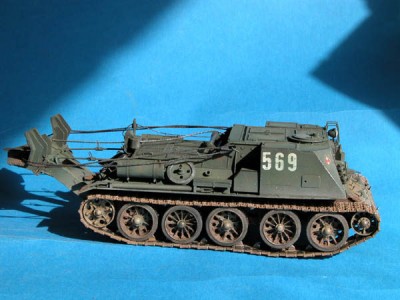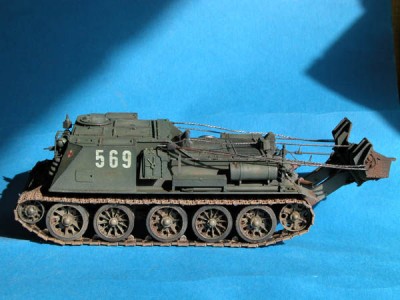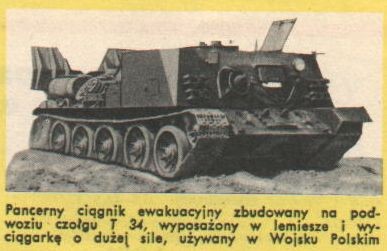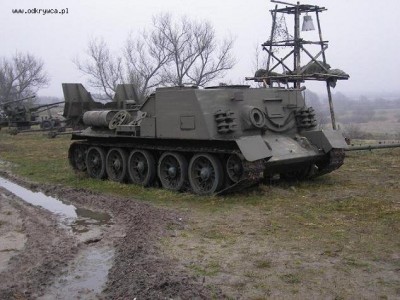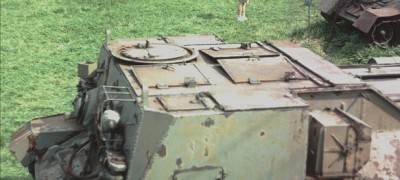On the T-34 chassis, the Poles produced an engineer-rescue tank marked CW-34.
Technically similar and inspired MS. VT-34.
Technical description:
The machine bottom was taken from the tank T-34-85. The rear part of the hull, which covered the engine compartment, was identical to the T-34 tank. The front of the superstructure was of new construction, it had space for the drum of the main winch of the tow rope and workplaces for two crew members. The superstructure consisted of a weldment of armor plates, which protected the crew from small arms fire and shrapnel from grenades. Two entrance hatches for the crew were placed on the ceiling of the superstructure. On the right, above the commander's seat, is a periscope. Behind them are two more hatches that allow access to the winch. On the sides of these covers were also hatches that allowed access to boxes with additional equipment of the tank.
The reel drum had a diameter of 1,090 mm, with a length of 1,280 mm. The main steel rope, 128 m long and 33 mm in diameter, was dimensioned for a tension of up to 30 tons directly and with the help of three pulleys up to 120 tons. The drum was driven via an auxiliary gearbox from the engine crankshaft. The main winch was controlled from the driver's seat by two levers. One controlled the forward and reverse travel of the drum, and the other controlled the common clutch and drum brake. The third lever controlled a gear clutch that connected the drum drive to the auxiliary gearbox and motor. The maximum pulling force of a single rope was, as we know, 30 t, against exceeding this limit, the rope was equipped with a tension sensor, which signaled to the crew the immediate load on the rope. To guide the rope to the vehicle axle, a so-called guide pulley cross was placed at the end of the engine cover. It consisted of two horizontal and two vertical pulleys. In front of this cross was a rope cleaner.
The tank has a tilting blade-support in the rear part, which ensures better stability and anchoring of the rescue tank when pulling forces over 30 t. Its width is 2,300 mm, for its lifting and lowering was used a tow rope, which with its end eye caught in the notch blades. In the transport position, the blade was secured with two tensioners and a tensioned tow rope.
In the left rear part (in the direction of travel) was an auxiliary winch, used when handling the main rope. The auxiliary winch was equipped with a rope with a diameter of 8 mm and a length of 240 m. The maximum pulling force with this rope was 500 kg. When this value was exceeded, the clutch transmitting torque from the main winch began to slip. A pulley located on the left rear part of the engine compartment superstructure served for the correct guidance of the auxiliary winch rope. Various auxiliary equipment were placed on the outside of the tank.
On the right fender behind the superstructure (in the direction of travel) was a box with a portable headlight and a drum for a 240 m long extension cable. There were also two rods on the fenders, which connected to a "V" and were used to tow immobile equipment. Other equipment were two pulleys with calipers, one with an eye, four hooks "C", and two jacks "Seguro" with a load capacity of 25 t.
Later series, in addition to a slight change of armor above the engine received elements of modification for deep wading from the modification of M-2 standard T-34-85, namely fixing the flange of sealing sleeves on the front machine gun, installation of seals in all hatches and periscopes, installation of blinds and intake flaps space with hinged covers. The exhaust pipe received a flange for mounting the non-return valve. An inlet pipe up to 3,500 mm long was mounted on the commander's hatch, which also serves as an air supply to the engine. This adjustment forced the right inlet hatch to change to a circular one.
The power unit consisted of a standard diesel, water-cooled twelve-cylinder V-2-34, later upgraded to V-2-34M. The volume of transported fuel was 530 l, of which 350 l in the inner tanks and 180 l in the two outer tanks on the sides of the engine compartment.
The vehicle was armed with a 7.62 mm DTM light machine gun, operated by the vehicle commander.
Dimensions + TTD:
Total length: 7,850 mm
Width: 3,000 mm
Total height: 2,460 mm
Working height of the winch: 2,025 mm
Clear height: 400 mm
Combat weight: 31,000 kg
Engine power: 500pcs/375 kW
Maximum speed on the road: 55 km/h
Maximum speed in the field: 25 km/h
Road fuel consumption: 160 l/100 km
Off-road fuel consumption: 230 l/100 km
Road distance: 220 km
Range: 160 km
Climb: 30 °
Lateral inclination: 25 °
Trench: 2,500 mm
Vertical wall: 730 mm
Ship: 1,300 mm
Rescue tanks VT-34 were included in the battalions of technical security tank and motorized rifle divisions.
These machines were used by the Polish army at least until the 1980s.
Technically similar and inspired MS. VT-34.
Technical description:
The machine bottom was taken from the tank T-34-85. The rear part of the hull, which covered the engine compartment, was identical to the T-34 tank. The front of the superstructure was of new construction, it had space for the drum of the main winch of the tow rope and workplaces for two crew members. The superstructure consisted of a weldment of armor plates, which protected the crew from small arms fire and shrapnel from grenades. Two entrance hatches for the crew were placed on the ceiling of the superstructure. On the right, above the commander's seat, is a periscope. Behind them are two more hatches that allow access to the winch. On the sides of these covers were also hatches that allowed access to boxes with additional equipment of the tank.
The reel drum had a diameter of 1,090 mm, with a length of 1,280 mm. The main steel rope, 128 m long and 33 mm in diameter, was dimensioned for a tension of up to 30 tons directly and with the help of three pulleys up to 120 tons. The drum was driven via an auxiliary gearbox from the engine crankshaft. The main winch was controlled from the driver's seat by two levers. One controlled the forward and reverse travel of the drum, and the other controlled the common clutch and drum brake. The third lever controlled a gear clutch that connected the drum drive to the auxiliary gearbox and motor. The maximum pulling force of a single rope was, as we know, 30 t, against exceeding this limit, the rope was equipped with a tension sensor, which signaled to the crew the immediate load on the rope. To guide the rope to the vehicle axle, a so-called guide pulley cross was placed at the end of the engine cover. It consisted of two horizontal and two vertical pulleys. In front of this cross was a rope cleaner.
The tank has a tilting blade-support in the rear part, which ensures better stability and anchoring of the rescue tank when pulling forces over 30 t. Its width is 2,300 mm, for its lifting and lowering was used a tow rope, which with its end eye caught in the notch blades. In the transport position, the blade was secured with two tensioners and a tensioned tow rope.
In the left rear part (in the direction of travel) was an auxiliary winch, used when handling the main rope. The auxiliary winch was equipped with a rope with a diameter of 8 mm and a length of 240 m. The maximum pulling force with this rope was 500 kg. When this value was exceeded, the clutch transmitting torque from the main winch began to slip. A pulley located on the left rear part of the engine compartment superstructure served for the correct guidance of the auxiliary winch rope. Various auxiliary equipment were placed on the outside of the tank.
On the right fender behind the superstructure (in the direction of travel) was a box with a portable headlight and a drum for a 240 m long extension cable. There were also two rods on the fenders, which connected to a "V" and were used to tow immobile equipment. Other equipment were two pulleys with calipers, one with an eye, four hooks "C", and two jacks "Seguro" with a load capacity of 25 t.
Later series, in addition to a slight change of armor above the engine received elements of modification for deep wading from the modification of M-2 standard T-34-85, namely fixing the flange of sealing sleeves on the front machine gun, installation of seals in all hatches and periscopes, installation of blinds and intake flaps space with hinged covers. The exhaust pipe received a flange for mounting the non-return valve. An inlet pipe up to 3,500 mm long was mounted on the commander's hatch, which also serves as an air supply to the engine. This adjustment forced the right inlet hatch to change to a circular one.
The power unit consisted of a standard diesel, water-cooled twelve-cylinder V-2-34, later upgraded to V-2-34M. The volume of transported fuel was 530 l, of which 350 l in the inner tanks and 180 l in the two outer tanks on the sides of the engine compartment.
The vehicle was armed with a 7.62 mm DTM light machine gun, operated by the vehicle commander.
Dimensions + TTD:
Total length: 7,850 mm
Width: 3,000 mm
Total height: 2,460 mm
Working height of the winch: 2,025 mm
Clear height: 400 mm
Combat weight: 31,000 kg
Engine power: 500pcs/375 kW
Maximum speed on the road: 55 km/h
Maximum speed in the field: 25 km/h
Road fuel consumption: 160 l/100 km
Off-road fuel consumption: 230 l/100 km
Road distance: 220 km
Range: 160 km
Climb: 30 °
Lateral inclination: 25 °
Trench: 2,500 mm
Vertical wall: 730 mm
Ship: 1,300 mm
Rescue tanks VT-34 were included in the battalions of technical security tank and motorized rifle divisions.
These machines were used by the Polish army at least until the 1980s.
